Mass 1
In today’s lesson, we will be learning about mass. The learning objectives are:
- Comparing Mass
- Measuring Mass
1. Comparing Mass
Mass refers to how heavy an item is. To compare the mass of two or more items, we can place them on a balance scale. The heavier object will tilt the balance downwards.

Is the hamburger heavier or lighter than the bowl of ramen?
The hamburger is lighter than the bowl of ramen.
The bowl of ramen is heavier than the hamburger.
Example:
Look at the diagram below.
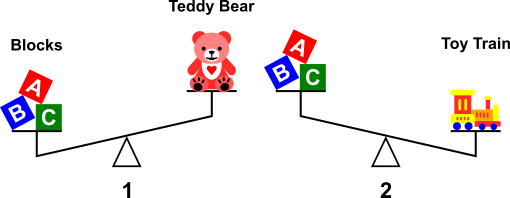
- Which of the following is the lightest?
Solution:
Balance scale 1:
The blocks are heavier than the teddy bear.
The teddy bear is lighter than the blocks.
Balance scale 2:
The blocks are lighter than the toy train.
The toy train is heavier than the blocks.
The teddy bear is the lightest.
Answer:
Teddy bear
- Arrange the items in order of the heaviest to the lightest, we have:
Toy train, Blocks, Teddy bear
Answer:
Toy train, Blocks, Teddy bear
Question 1:
Which item is the lightest?
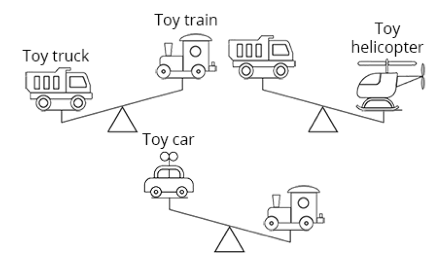
- Toy truck
- Toy train
- Toy helicopter
- Toy car
Solution:
The toy truck is lighter than the toy helicopter.
The toy train is lighter than the toy truck.
The toy car is lighter than the toy train.
So, the toy car is the lightest.
Answer:
(4) Toy car
Question 2:
Which of the following is the heaviest?
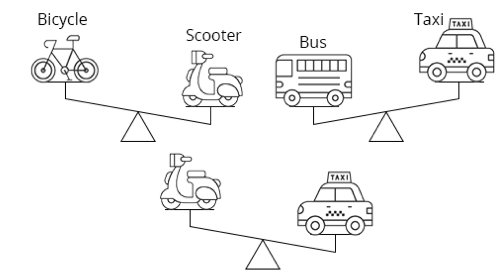
- Bicycle
- Scooter
- Bus
- Taxi
Solution:
The scooter is heavier than the bicycle.
The taxi is heavier than the scooter.
The bus is heavier than the taxi.
So, the bus is the heaviest.
Answer:
(3) Bus
Question 3:
Which of the following shows the masses of items arranged in order, starting with the lightest?
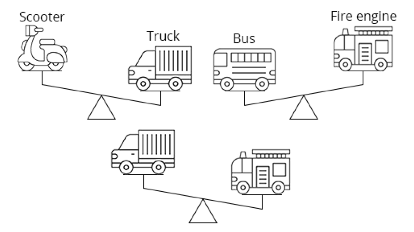
- Scooter, Truck, Bus, Fire Engine
- Bus, Fire Engine, Truck, Scooter
- Scooter, Truck, Fire Engine, Bus
- Scooter, Truck, Bus, Fire Engine
Solution:
The scooter is lighter than the truck.
The fire engine is lighter than the bus.
The truck is lighter than the fire engine.
So, the scooter is the lightest.
Answer:
(3) Scooter, Truck, Fire Engine, Bus
2. Measuring Mass
To measure the mass of an object, we can use a balance scale or a weighing scale. When using a balance scale, we will place the object on one side of the scale and add weights to the other side until the scale balances.
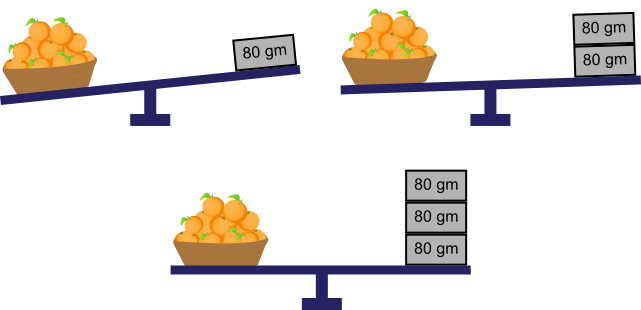
Mass of the basket of oranges
\(\begin{align} &= 80 \text{ g } + 80 \text{ g } + 80 \text{ g } \\[2ex] &= 240 \text{ g } \end{align}\)
OR
Mass of the basket of oranges
\(\begin{align} &= 3 \text{ g} \times 80 \text{ g } \\[2ex] &= 240 \text{ g } \end{align} \)
The mass of the oranges is 240 g.
Question 1:
Look at the diagram below. What is the mass of the bunch of bananas?

- 250 g
- 300 g
- 400 g
- 500 g
Solution:
Mass of the bunch of bananas
\(\begin{align} &= 250 \text{ g } + 250 \text{ g } \\[2ex] &= 500 \text{ g } \end{align}\)
Answer:
(4) 500 g
Question 2:
What is the mass of the books?

- 5 kg
- 10 kg
- 15 kg
- 555 kg
Solution:
Mass of the books
\(\begin{align} &= 3 \text{ g } \times 5 \text{ g } \\[2ex] &= 15 \text{ g } \end{align}\)
Answer:
(3) 15 kg
Question 3:
The mass of the toy car is __________.

- 100 g
- 105 g
- 110 g
- 115 g
Solution:
Total mass of weights on the right
\(\begin{align} &= 100 \text{ g } + 15 \text{ g } + 15 \text{ g }\\[2ex] &= 130 \text{ g } \end{align}\)
Mass of the toy car
\(\begin{align} &= 130 \text{ g } - 25 \text{ g } \\[2ex] &= 105 \text{ g } \end{align}\)
Answer:
(2) 105 g
Measuring Mass
To measure the mass of an object, we can also use a weighing scale.
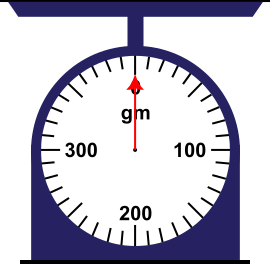
When using a weighing scale, we will first need to determine the value of each interval. Then, we can identify the mass of the object.
Let’s weigh a basket of apples. First, we need to identify the value of each interval on the scale.
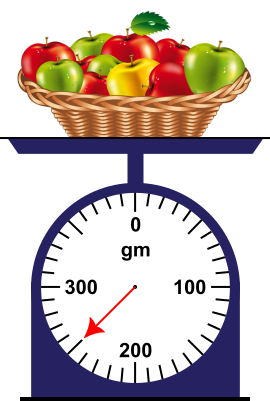
Between 0 and 100, there are 10 intervals.
Value of 10 intervals \(= 100 \text{ g}\)
Value 1 interval
\(= 100 \text{ g} ÷ 10 \\[2ex] = 10 \text{ g}\)
In the scale shown, the needle is pointing 5 intervals after 200 g.
Value of 5 intervals
\(= 5 \times 10 \text{ g} \\[2ex] = 50 \text{ g} \)
Mass of the basket of apples
\(= 200 \text{ g} + 50 \text{ g}\\[2ex] = 250 \text{ g}\)
Question 1:
What is the mass of the notebook?
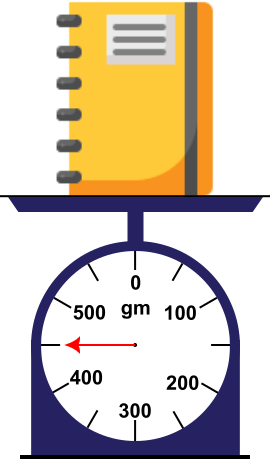
- 400 g
- 425 g
- 450 g
- 490 g
Solution:
Value of 2 intervals \(= 100 \text{ g}\)
Value of 1 interval
\(= 100 \text{ g} \div 2 \\[2ex] = 50 \text{ g}\)
Mass of the notebook
\(= 400 \text{ g} + 50 \text{ g}\\[2ex] = 450 \text{ g}\)
Answer:
(3) 450 g
Question 2:
What is the mass of the baseball?
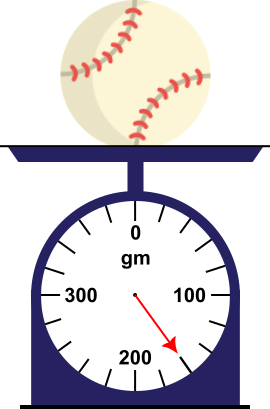
- 100 g
- 230 g
- 160 g
- 200 g
Solution:
Value of 5 intervals \(= 100 \text{ g}\)
Value of 1 interval
\(\begin{align} &= 100 \text{ g } \div 5 \\[2ex] &= 20 \text{ g } \end{align}\)
Value of 3 intervals
\(\begin{align} &= 3 \times 20 \text{ g } \\[2ex] &= 60 \text{ g } \end{align}\)
Mass of the baseball
\(\begin{align} &= 100 \text{ g } + 60 \text{ g } \\[2ex] &= 160 \text{ g } \end{align}\)
Answer:
(3) 160 g
Question 3:
The diagram shows the mass of a plate of turkey. The mass of the empty plate is 80 g. What is the mass of the turkey?
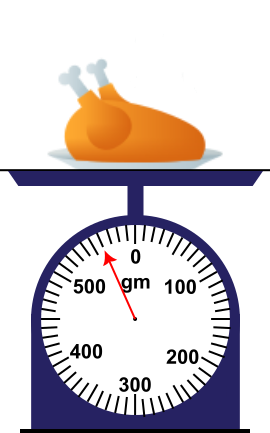
- 420 g
- 450 g
- 480 g
- 640 g
Solution:
Value of 1 interval \(= 10 \text{ g}\)
Mass of the turkey with the plate
\(\begin{align} &= 500 \text{ g } + 60 \text{ g } \\[2ex] &= 560 \text{ g } \end{align}\)
Mass of the turkey
\(\begin{align} &= 560 \text{ g } - 80 \text{ g } \\[2ex] &= 480 \text{ g } \end{align}\)
Answer:
(4) 480 g
Question 4:
What is the mass of the packet of french fries?

- 190 g
- 210 g
- 230 g
- 250 g
Solution:
Scale 1:
Mass of Ketchup \(+ \;60 \text{ g} = 230 \text{ g}\)
Mass of Ketchup
\(\begin{align} &= 230 \text{ g} - 60 \text{ g } \\[2ex] &= 170 \text{ g } \end{align}\)
Scale 2:
\(170 \text{ g } +\) Mass of French fries \(= 420 \text{ g}\)
Mass of French fries
\(\begin{align} &= 420 \text{ g} - 170 \text{ g } \\[2ex] &= 250 \text{ g } \end{align}\)
Answer:
(4) 250 g
In this article, we learnt:
- Comparing Mass
To compare the mass of objects, we have to remember that the heavier object will tilt the balance scale downwards.
- Measuring Mass
To measure the mass of object, we will first need to determine the value of each interval on the weighing scale and then determine the mass of the object.


 SG
SG  VN
VN 

















